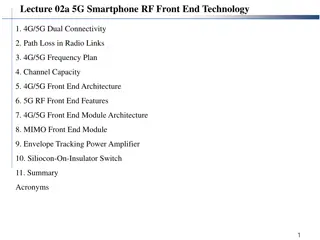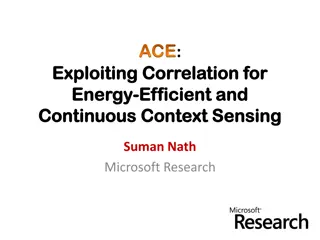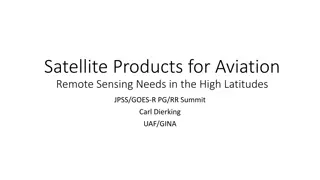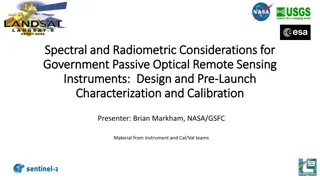Smartphone Market Trends, Analysis, and Outlook
The smartphone market size reached an impressive $522 billion, , the smartphone market is anticipated to exceed 1.5 billion units in sales by the end of 2023.
0 views • 3 slides
Global Foldable Smartphone Market
The Global Foldable Smartphone Market Size is Anticipated to Exceed USD 131.91 Billion by 2033, Growing at a CAGR of 16.93% from 2023 to 2033.\n\n
1 views • 4 slides
Master Your Smartphone GPS and Mapping Apps for Effortless Navigation
Unlock the true potential of your smartphone GPS with this comprehensive guide on navigation and mapping apps. Learn how to never get lost again, whether you're driving, hiking, or exploring off-road. Discover a range of apps for different activities, from vehicle navigation to sharing locations and
4 views • 14 slides
Understanding Remote Sensing Sensor Resolutions & Colour Composite
Explore the art and science of remote sensing, detailing sensor types, resolution categories, and color composite techniques. Learn about the stages involved in remote sensing, sensor variations, and band designations for satellites like Landsat 8. Discover the significance of pixel, high-resolution
3 views • 13 slides
Latest Consensus on UWB Sensing for 802.15.4ab
Co-authors from various companies present the latest agreement on ultra-wideband (UWB) sensing topics for the IEEE 802.15.4ab standard. The consensus includes definitions for sensing pulse shape, packet formats for bi/multi-static sensing, and support for specific sequences and patterns in UWB sensi
1 views • 27 slides
Comparing Virtual Reality (VR), Augmented Reality (AR), and Mixed Reality (MR)
Virtual Reality (VR) immerses users in a digital environment using headsets, Augmented Reality (AR) overlays computer-generated content on the real world, and Mixed Reality (MR) combines digital content with real-world interactions through wearable devices like glasses. VR isolates users, AR enhance
1 views • 22 slides
Spectrum Sensing for Enhanced Channel Access in Wireless Networks
This document presents a proposal for Spectrum Sensing Based Deferral (SSBD) to improve channel access in wireless networks. SSBD incorporates spectrum sensing with transmission deferral in a time-bound manner to enhance performance, reliability, and latency control. The proposed solution safeguards
1 views • 11 slides
IEEE 802.11-21/1321r1 WLAN Sensing Procedure Proposal
This document by Solomon Trainin from Qualcomm presents a proposal on aligning the SFD for the WLAN sensing procedure. It aims to resolve contradictions, optimize behavior, and introduce a structured WLAN sensing procedure. The content outlines phases, terminology, setup, measurement, and reporting
0 views • 8 slides
Study on Smartphone Addiction Across Age and Gender During Italian COVID-19 Lockdown
This pilot study aims to investigate smartphone dependence levels during the Italian lockdown for COVID-19. Nomophobia, the fear of being without a mobile phone, is explored, highlighting its impact on individuals' behaviors and emotions. The study reveals how smartphones served as crucial tools for
0 views • 24 slides
IEEE 802.11-21/2011r0 Sensing NDP Announcement Overview
This document presents an overview of the IEEE 802.11-21/2011r0 Sensing NDP Announcement for utilizing NDP in sensing applications. It discusses the motivation behind NDP sensing, outlines the NDP Announcement frames, and explains possible sensing frame exchange sequences. The Ranging NDP Announceme
0 views • 8 slides
IEEE 802.11-19/1769: CSI-based Wi-Fi Sensing Results & Challenges
This document from Oct. 2019 explores IEEE 802.11-19/1769 CSI-based Wi-Fi sensing, focusing on results and standardization challenges. It delves into the concept of Wi-Fi sensing, its applications in security, automation, healthcare, and more, as well as the importance of CSI parameters such as reso
0 views • 10 slides
Wi-Fi Sensing in IoT: Advantages, Use Cases, and Challenges
Wi-Fi sensing utilizes Wi-Fi devices/network to detect presence, range, angle, and velocity of passive/non-transceiver objects. This document discusses the definition, advantages, use cases like smart home applications, and challenges of Wi-Fi sensing compared to other sensing technologies. It also
6 views • 15 slides
Exploring Wi-Fi Sensing for Motion Detection and Beyond
The document discusses the utilization of Wi-Fi signals for sensing various features in a given environment, such as motion, presence, gesture, and more, without assuming the subject carries a Wi-Fi device. It covers applications, technical principles, and a three-phase algorithm for motion detectio
0 views • 24 slides
From Paintbrush to Smartphone: The Evolution of Bird Identification Since "The B
Explore the evolution of bird identification from 'The Birds of America' book to modern smartphone apps. Discover how technology has transformed birdwatching.
1 views • 5 slides
Wireless Sensing Privacy Discussions in May 2023 Document
May 2023 document (.IEEE 802..11-23-0782-00-00bf) discusses privacy issues related to wireless sensing, including unauthorized access to sensing reports, tracking of sensing devices, and potential eavesdropping on sensing signals. It proposes solutions to protect sensitive information and addresses
4 views • 12 slides
Exploring 5G Smartphone RF Front End Technology
Delve into the world of 5G smartphone RF front end technology covering aspects like 4G/5G dual connectivity, path loss in radio links, frequency plan, channel capacity, front end architecture, MIMO modules, envelope tracking power amplifier, and more. Discover the features of 5G RF front end includi
1 views • 19 slides
Comparison of Trigger-based vs. Non-Trigger-based Sensing Measurement in IEEE 802.11
The document discusses the differences between Trigger-based (TB) and Non-Trigger-based (Non-TB) sensing measurement instances in IEEE 802.11 standards, focusing on who initiates the sensing measurement. TB sensing is initiated by the AP, while Non-TB sensing is initiated by a non-AP STA, enabling o
6 views • 13 slides
IEEE P802.15 WPAN Sensing Device Submission
This submission to the IEEE P802.15 Working Group focuses on the development of a sensing device for Wireless Personal Area Networks (WPANs). The document discusses the integration of Ultra-Wideband (UWB) technology for sensing applications, including presence detection and environment mapping. Key
0 views • 16 slides
Exploring Wi-Fi Sensing: Feasibility and Standardization Gaps
Delve into the technical aspects of Wi-Fi sensing, discussing its definition, feasibility, and standardization gaps according to the IEEE 802.11 standard. The presentation highlights the ability of Wi-Fi systems to detect environmental changes and explores scientific publications related to Wi-Fi se
0 views • 27 slides
Wireless LAN Sensing Use Cases in Home Environments
The document discusses use cases for Wireless LAN (WLAN) sensing in home environments, focusing on the connection between multiple access points and home appliances for enhanced performance. It outlines scenarios such as gesture-controlled home appliance operation, user identification for personaliz
0 views • 11 slides
How Interactive Widgets Revolutionize Smartphone Experience
In the ever-evolving world of smartphone technology, smartphone usage has increased significantly. You might find yourself tapping on your lock screen to either check time or notifications. But now, user interface (UI) innovations continue to reshape
0 views • 6 slides
IEEE 802.11-21/0391r0: Minimizing Impact in WLAN Sensing Design
The document presents discussions on minimizing impact as a design goal within the IEEE 802.11-21/0391r0 context, emphasizing the efficiency related to the impact of sensing on network performance. It addresses the current status, constraints, design options, and thoughts regarding WLAN sensing with
1 views • 8 slides
The Impact of Smartphone Culture on Teens at Camp: Research Insights and Strategies
Discover the alarming statistics of smartphone addiction among teens and how camps can serve as a refuge from this digital dependency. Gain insights on educating parents, marketing unplugged policies, and promoting face-to-face interactions to enhance camp experiences. Explore research methodology,
0 views • 15 slides
Remote Sensing Methods for Identifying Degraded Forests in the Amazon
Using multisource remote sensing data, this study aims to identify and characterize forest degradation in the Amazonian landscape. Field work in Paragominas, Brazil, combined with optical and radar data analysis, helps in understanding carbon stocks and typology of degraded forests. The research foc
3 views • 7 slides
Understanding Hall Effect Sensors in Electronic Labs
Hall Effect sensors play a crucial role in detecting magnetic fields, enabling applications such as current sensing, rotational speed measurement in motors, and magnetic proximity sensing. They operate based on the Hall Effect phenomenon, where a magnetic field influences the flow of current in a se
2 views • 5 slides
Sparse Millimeter-Wave Imaging Using Compressed Sensing and Point Spread Function Calibration
A novel indoor millimeter-wave imaging system based on sparsity estimated compressed sensing and calibrated point spread function is introduced. The system utilizes a unique calibration procedure to process the point spread function acquired from measuring a suspended point scatterer. By estimating
2 views • 26 slides
Exploring Applications of Remote Sensing in Environmental Studies
Dr. Sanjib Pramanik, an Assistant Professor at Durga College, delves into the fascinating realm of remote sensing for environmental studies. Remote sensing allows data collection from a distance, utilizing methods like air photos and satellite imagery. The environment comprises components such as na
0 views • 35 slides
Advances in Remote Sensing for Soil Moisture Validation and Calibration
Cutting-edge methods like Cosmic-Ray Neutron Sensing (CRNS) and mobile measurements are revolutionizing soil moisture validation and calibration. From satellite-based techniques to local approaches, researchers are enhancing the accuracy and reliability of soil moisture data for various applications
0 views • 15 slides
Analysis of Smartphone Usage Trends Among Teens - November 2013, Espoo, Finland
Analysis of smartphone usage trends among teenagers in November 2013, conducted in Espoo, Finland by Bojan Maljevac. The survey covers aspects such as smartphone ownership, daily usage hours, purposes of use, attitudes towards smartphone use for school, and opinions on smart devices as learning tool
0 views • 11 slides
Remote Sensing for Blue Whale Conservation: Enhancing Maritime Policy
Using remote sensing technology to monitor blue whale habitats can help address the conservation challenges posed by ship strikes. By predicting species distributions with greater precision, regulatory agencies can implement effective measures to reduce the risks faced by blue whales. Remote sensing
0 views • 18 slides
Automated Concolic Testing of Smartphone Apps
This research focuses on automated concolic testing of smartphone apps, addressing problems and solutions related to generating test inputs for exhaustive testing. It explores the challenges of generating individual events and sequences of events in smartphone applications, aiming to enhance testing
0 views • 47 slides
Efficient Context Sensing for Mobile Applications
Leveraging correlations between different user contexts, the ACEACE framework by Suman Nath explores energy-efficient continuous context sensing for mobile apps. By inferring expensive attributes from cheaper ones, the system optimizes sensing tasks based on human activities, significantly reducing
0 views • 23 slides
Satellite Products for Aviation Remote Sensing Needs in High Latitudes
Addressing the specific needs of aviation remote sensing in high latitudes, this content explores the importance of satellite products, variations in equipment requirements, data expectations, and the significance of cloud products for aviation safety. Feedback from aircraft operators emphasizes the
0 views • 8 slides
Spectral and Radiometric Considerations for Government Remote Sensing Instruments
This presentation explores the important considerations in designing and calibrating government passive optical remote sensing instruments, focusing on spectral and radiometric aspects. Topics include spectral variation, design considerations, uniformity, reflectance calibration, and examples from i
0 views • 27 slides
Radiometric Calibration Methods for Remote Sensing Applications
Techniques for radiometric calibration in remote sensing include vicarious approaches utilizing invariant desert sites, in-situ methods characterizing surfaces and atmospheres, and SI-traceable measurements for intercomparisons between sensors. The repeatability of in-situ results and comparison wit
0 views • 20 slides
Remote Sensing Panel Discussion: Addressing Challenges in RFI Reporting, Regulations, and Protection of Operations
The Remote Sensing panel discussion highlights key issues such as the lack of RFI reporting to the ITU, importance of RFI reporting for regulatory enforcement, obstacles in protecting remote sensing operations, desired changes in Radio Regulations, and potential discussion points for the research an
0 views • 7 slides
Enhancing Robot Control in Neurosurgery through Force Sensing Integration
The project aims to improve the cooperative control of the Galen robot in neurosurgery by measuring and integrating tool-to-tissue forces. By sensing these forces, the system can enhance visual feedback, establish safety limits, evaluate surgical skills, and allow unbiased comparisons of techniques.
0 views • 12 slides
Enhancing Smartphone Location Sensing Efficiency
This study delves into optimizing energy consumption in smartphone location sensing mechanisms like GPS and Network Based Triangulation. Comparisons of battery drainage rates with and without GPS provide insights. Additionally, the energy efficiency of Network Based Triangulation as a less accurate
1 views • 41 slides
Cognitive Radio Network and Game Theory Exploration at University of Houston
Explore the application of cooperative game theory in cognitive radio networks, focusing on spectrum sensing, dynamic spectrum access, and coalitional games. Detailed overview of research conducted at the Department of Electrical and Computer Engineering, University of Houston. Learn about cognitive
0 views • 42 slides
Constrained Adaptive Sensing and Benefits of Adaptivity
Constrained adaptive sensing involves estimating sparse signals with constraints, utilizing strategies like nonadaptive sensing and adaptive sensing. Benefits of adaptivity include reducing errors and improving estimation accuracy in signal processing. It explores the potential for improvement in re
0 views • 17 slides







































